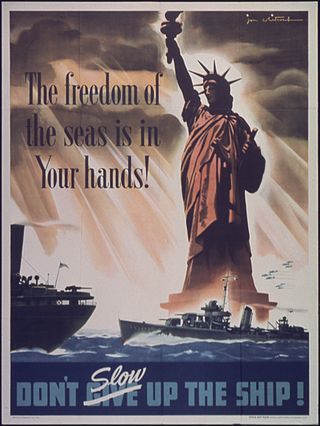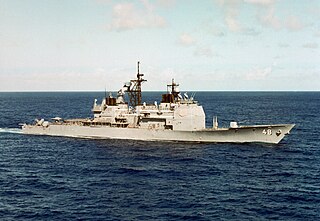Related Research Articles

The United Nations Convention on the Law of the Sea (UNCLOS), also called the Law of the Sea Convention or the Law of the Sea Treaty, is an international treaty that establishes a legal framework for all marine and maritime activities. As of July 2024, 169 States and the European Union are parties.
Admiralty law or maritime law is a body of law that governs nautical issues and private maritime disputes. Admiralty law consists of both domestic law on maritime activities, and private international law governing the relationships between private parties operating or using ocean-going ships. While each legal jurisdiction usually has its own legislation governing maritime matters, the international nature of the topic and the need for uniformity has, since 1900, led to considerable international maritime law developments, including numerous multilateral treaties.

An artificial island or man-made island is an island that has been constructed by humans rather than formed through natural processes. Other definitions may suggest that artificial islands are lands with the characteristics of human intervention in their format process, while others argue that artificial islands are created by expanding existing islets, constructing on existing reefs, or amalgamating several islets together. Although constructing artificial islands is not a modern phenomenon, there is no definite legal definition of it. Artificial islands may vary in size from small islets reclaimed solely to support a single pillar of a building or structure to those that support entire communities and cities. Archaeologists argue that such islands were created as far back as the Neolithic era. Early artificial islands included floating structures in still waters or wooden or megalithic structures erected in shallow waters.

The terms international waters or transboundary waters apply where any of the following types of bodies of water transcend international boundaries: oceans, large marine ecosystems, enclosed or semi-enclosed regional seas and estuaries, rivers, lakes, groundwater systems (aquifers), and wetlands.

Freedom of the seas is a principle in the law of the sea. It stresses freedom to navigate the oceans. It also disapproves of war fought in water. The freedom is to be breached only in a necessary international agreement.

Law of the sea is a body of international law governing the rights and duties of states in maritime environments. It concerns matters such as navigational rights, sea mineral claims, and coastal waters jurisdiction. The connotation of ocean law is somewhat broader, but the law of the sea is so comprehensive that it covers all areas of ocean law as well.

An exclusive economic zone (EEZ), as prescribed by the 1982 United Nations Convention on the Law of the Sea, is an area of the sea in which a sovereign state has exclusive rights regarding the exploration and use of marine resources, including energy production from water and wind.
Freedom of navigation (FON) is a principle of law of the sea that ships flying the flag of any sovereign state shall not suffer interference from other states, apart from the exceptions provided for in international law. In the realm of international law, it has been defined as “freedom of movement for vessels, freedom to enter ports and to make use of plant and docks, to load and unload goods and to transport goods and passengers". This right is now also codified as Article 87(1)a of the 1982 United Nations Convention on the Law of the Sea.

Sir Creek, originally Ban Ganga, is a 96 km tidal estuary in the uninhabited marshlands of the Indus River Delta on the border between India and Pakistan. The creek flows into the Arabian Sea and separates Gujarat state in India from Sindh province in Pakistan. The long-standing India-Pakistan Sir Creek border dispute stems from the demarcation "from the mouth of Sir Creek to the top of Sir Creek, and from the top of Sir Creek eastward to a point on the line designated on the Western Terminus". From this point onward, the boundary is unambiguously fixed as defined by the Tribunal Award of 1968.

According to the United Nations Convention on the Law of the Sea, a nation's internal waters include waters on the side of the baseline of a nation's territorial waters that is facing toward the land, except in archipelagic states. It includes waterways such as rivers and canals, and sometimes the water within small bays.
Maritime Security Regimes are codes and conventions of behavior agreed upon by coastal states to provide a degree of security within territorial waters and on the high seas.
Transit passage is a concept of the law of the sea, which allows a vessel or aircraft the freedom of navigation or overflight solely for the purpose of continuous and expeditious transit of a strait between one part of the high seas or exclusive economic zone and another. The requirement of continuous and expeditious transit does not preclude passage through the strait for the purpose of entering, leaving or returning from a state bordering the strait, subject to the conditions of entry to that state. The transit passage may be exercised regardless of the nationality (flag) of the ship, its form of ownership, the merchant or government status of a ship or warship, the private or government status of an aircraft.

The Republic of Cyprus (Cyprus) and Turkey have been engaged in a dispute over the extent of their exclusive economic zones (EEZ), ostensibly sparked by oil and gas exploration in the area. Turkey objects to Cypriot drilling in waters that Cyprus has asserted a claim on. The present maritime zones dispute touches on the perennial Cyprus and Aegean disputes; Turkey is the only member state of the United Nations that does not recognise Cyprus, and is one of the countries which are not signatory to the United Nations Convention on the Law of the Sea, which Cyprus has signed and ratified.

The exclusive economic zone of Somalia covers 830,389 km2 in the Indian Ocean. It extends to a distance of 200 nautical miles from the baselines, from which the breadth of the nation's territorial waters is measured. In accordance with Law No. 37 passed in 1972, Somalia's EEZ falls under its territorial sovereignty.

On March 13, 1986, the American cruiser USS Yorktown and the destroyer USS Caron tried to exercise the right of innocent passage under international law through Soviet territorial waters in the Black Sea near the southern Crimean Peninsula. They were confronted by Soviet frigate Ladny and border guard vessels Dozorny and Izmail.

Japan has the eighth-largest exclusive economic zone (EEZ) in the world. The total area of Japan is about 380 thousand km2. Japan's EEZ area is vast and the territorial waters and EEZ together is about 4.47 million km2.

The exclusive economic zone of North Korea stretches 200 nautical miles from its basepoints in both the Yellow Sea and the Sea of Japan. The exclusive economic zone (EEZ) was declared in 1977 after North Korea had contested the validity of the Northern Limit Lines (NLL) set up after the Korean War as maritime borders. The EEZ has not been codified in law and North Korea has never specified its coordinates, making it difficult to determine its specific scope.

The exclusive economic zone of Canada is the area of the sea in which Canada has special rights regarding the exploration and use of marine resources, as prescribed by the 1982 United Nations Convention on the Law of the Sea.

The Spanish fishing trawler Sonia sank off the Cornish coast of England on 20 October 1984. On 19 October, in Irish territorial waters off the coast of County Wexford, the Sonia had been spotted by the Irish Naval Service patrol vessel Aisling and was suspected to be fishing illegally. The Sonia was ordered to halt and prepare to receive a boarding party, but did not comply.
A mar presencial or heritage marine reserve is a zone of influence demarcated by a maritime country in the high seas adjacent to its exclusive economic zone (EEZ). The objective of this oceanopolitical concept or doctrine, is to signal to third parties where the coastal country's interests are, or could be directly involved.
References
- 1 2 3 Glanville L. Williams (1939). "The juridical basis of hot pursuit". British Yearbook of International Law. 20: 83–97.
- ↑ Lehman, Jeffrey; Phelps, Shirelle (2005). West's Encyclopedia of American Law, Vol. 5 (2 ed.). Detroit: Thomson/Gale. p. 293. ISBN 9780787663742.
- ↑ R. v. Macooh, 1993 CanLII 107 (26 February 1993), Supreme Court (Canada)
- ↑ Nicholas M. Poulantzas (2002), The Right of Hot Pursuit in International Law, Brill–Martinus Nijhoff
- 1 2 Craig H. Allen (1989), "Doctrine of hot pursuit: A functional interpretation adaptable to emerging maritime law enforcement technologies and practices" (PDF), Ocean Development and International Law, 20 (4): 309–341, doi:10.1080/00908328909545899
- ↑ Lionel Beehner (Winter 2011). "Can nations 'pursue' non-state actors across borders?" (PDF). Yale Journal of International Affairs : 110–112. Archived from the original (PDF) on 2013-09-21. Retrieved 2013-04-25.